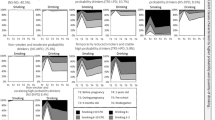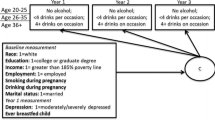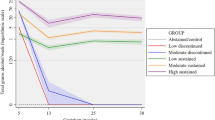Abstract
Objectives Despite potential health risks for women and children, one in five women report alcohol use during pregnancy and a significant proportion of those who quit during pregnancy return to drinking post-delivery. This study seeks to understand the longitudinal patterns of alcohol consumption before, during pregnancy and post-delivery, and the role of maternal characteristics for purposes of informing prevention design. Methods General growth mixture models were used to describe the average developmental patterns of maternal weekly drinking quantity at six time points, from preconception through child entering kindergarten, as well as heterogeneity in these patterns among 9100 mothers from the Early Childhood Longitudinal Study representing the 2001 US national birth cohort. Results Four distinct classes of mothers were defined by their longitudinal alcohol consumption patterns: Low Probability Drinkers (50.3 %), Escalating Risk Drinkers (12.0 %), Escalating Low Risk Drinkers (27.4 %), and Early Parenting Quitters (10.2 %). Heterogeneous covariate associations were observed. For example, mothers who gave birth after age 36 were twice as likely to be Escalating Risk Drinkers and Escalating Low Risk Drinkers (vs Low Probability Drinkers), but not more likely to be Early Parenting Quitters, when compared to mothers who gave birth between the ages of 26 and 35. Conclusions for practice There is significant heterogeneity in maternal longitudinal alcohol use patterns during the perinatal period. Baseline maternal characteristics and behavior associated with these heterogeneous patterns provide valuable tools to identify potential risky drinkers during this critical time period and may be synthesized to tailor pre- and postnatal clinical counseling protocols.


Similar content being viewed by others
References
Meyer-Leu, Y., et al. (2011). Association of moderate alcohol use and binge drinking during pregnancy with neonatal health. Alcoholism, Clinical and Experimental Research, 35, 1669–1677.
Sood, B., et al. (2001). Prenatal alcohol exposure and childhood behavior at age 6 to 7 years: I. Dose-response effect. Pediatrics, 108(2), e34.
Streissguth, A. P., et al. (1999). The long-term neurocognitive consequences of prenatal alcohol exposure: A 14-year study. Psychological Science, 10(3), 186–190.
Ethen, M., et al. (2009). Alcohol consumption by women before and during pregnancy. Maternal and Child Health Journal, 13, 274–285.
Olds, D. L., et al. (2002). Home visiting by paraprofessionals and by nurses: A randomized, controlled trial. Pediatrics, 110, 486–496.
United States of America, Legislative Base: Maternal and Child Health Services Block Grant; Title V of the Social Security Act: Compilation of Maternal and Child Health Legislation 1912–1996. 1996.
Laborde, N., & Mair, C. (2012). Alcohol use patterns among postpartum women. Maternal and Child Health Journal, 16, 1810–1819.
Substance Abuse and Mental Health Services Administration. (2009). Substance use among women during pregnancy and following childbirth, in the NSDUH Report. Substance abuse and mental health services administration. Rockville, MD: Office of Applied Studies.
Jagodzinski, T., & Fleming, M. F. (2007). Correlates of postpartum alcohol use. Wisconsin Medical Journal, 106, 319–325.
Fan, A. Z., et al. (2008). Patterns of alcohol consumption and the metabolic syndrome. Journal of Clinical Endocrinology and Metabolism, 93, 3833–3838.
Little, R. E., Lambert, M. D., & Worthington-Roberts, B. (1990). Drinking and smoking at 3 months postpartum by lactation history. Paediatric and Perinatal Epidemiology, 4, 290–302.
Jester, J. M., et al. (2000). The influence of maternal drinking and drug use on the quality of the home environment of school-aged children. Alcoholism, Clinical and Experimental Research, 24(8), 1187–1197.
Jonas, D. E., et al. (2012). Behavioral counseling after screening for alcohol misuse in primary care: A systematic review and meta-analysis for the us preventive services task force. Annals of Internal Medicine, 157, 645–654.
Turnbull, C., & Osborn, D. A. (2012). Home visits during pregnancy and after birth for women with an alcohol or drug problem. Cochrane Database of Systematic Reviews, (1).
Fleming, M. F., et al. (2008). The healthy moms study: The efficacy of brief alcohol intervention in postpartum women. Alcoholism-Clinical and Experimental Research, 32, 1600–1606.
Rutter, M. (1996). Transitions and turning points in developmental psychopathology: As applied to the age span between childhood and mid-adulthood. International Journal of Behavioral Development, 19, 603–626.
Staff, J., et al. (2014). Family transitions and changes in drinking from adolescence through mid-life. Addiction, 109(2), 227–236.
Fergusson, D. M., Boden, J. M., & Horwood, L. J. (2012). Transition to parenthood and substance use disorders: findings from a 30-year longitudinal study. Drug and Alcohol Dependence, 125(3), 295–300.
Wolfe, J. D. (2009). Age at first birth and alcohol use. Journal of Health and Social Behavior, 50, 395–409.
Haynes, G., Dunnagan, T., & Christopher, S. (2003). Determinants of alcohol use in pregnant women at risk for alcohol consumption. Neurotoxicology and Teratology, 25(6), 659.
Meschke, L. L., et al. (2008). Correlates of prenatal alcohol use. Maternal and Child Health Journal, 12, 442–451.
Duncan, E. M., Forbes-McKay, K. E., & Henderson, S. E. (2012). Alcohol use during pregnancy: An application of the theory of planned behavior. Journal of Applied Social Psychology, 42, 1887–1903.
Skagerstrom, J., Chang, G., & Nilsen, P. (2011). Predictors of drinking during pregnancy: A systematic review. Journal of Womens Health, 20(6), 901–913.
Jagodzinski, T., & Fleming, M. F. (2007). Postpartum and alcohol-related factors associated with the relapse of risky drinking. Journal of studies on Alcohol and Drugs, 68, 879–885.
McLeod, D., et al. (2002). Factors influencing alcohol consumption during pregnancy and after giving birth. New Zealand Medical Journal, 115(1157), U29.
Parackal, S., Ferguson, E., & Harraway, J. (2007). Alcohol and tobacco consumption among 6–24-months post-partum New Zealand women. Maternal and Child Nutrition, 3(1), 40–51.
Liu, W., Mumford, E. A., & Petras, H. (2015). Maternal patterns of postpartum alcohol consumption by age: A longitudinal analysis of adult urban mothers. Prevention Science, 16(3), 353–363.
Najarian, M. (2010). Early childhood longitudinal study, birth cohort (ECLS-B), preschool-kindergarten 2007 psychometric report. Washington, DC: National Center for Education Statistics, Institute of Education Sciences, US Department of Education.
National Center for Education Statistics. Early Childhood Longitudinal Program. http://nces.ed.gov/ecls/birthdatainformation.asp. Accessed 8 June 2012.
Alvik, A., et al. (2006). Alcohol consumption before and during pregnancy comparing concurrent and retrospective reports. Alcoholism-Clinical and Experimental Research, 30, 510–515.
May, P. A., et al. (2009). Prevalence and epidemiologic characteristics of FASD from various research methods with an emphasis on recent in-school studies. Developmental Disabilities Research Reviews, 15(3), 176–192.
Hannigan, J. H., et al. (2010). A 14-year retrospective maternal report of alcohol consumption in pregnancy predicts pregnancy and teen outcomes. Alcohol, 44(7–8), 583–594.
Arbuckle, J. L. (1996). Full information estimation in the presence of incomplete data. In G. A. Marcoulides & R. E. Schumacker (Eds.), Advanced Structural Equation Modeling: Issues and Techniques (pp. 243–277). Mahwah, NJ: Erlbaum.
Schafer, J. L., & Graham, J. W. (2002). Missing data: Our view of the state of the art. Psychological Methods, 7(2), 147–177.
White, H. (1980). A heteroskedasticity-consistent covariance matrix estimator and a direct test for heteroskedasticity. Econometrica: Journal of the Econometric Society, 48, 817–838.
Brown, C. W., Olson, H. C., & Croninger, R. G. (2010). Maternal alcohol consumption during pregnancy and infant social, mental, and motor development. Journal of Early Intervention, 32(2), 110–126.
Del Boca, F. K., & Darkes, J. (2003). The validity of self-reports of alcohol consumption: State of the science and challenges for research. Addiction, 98, 1–12.
Radloff, L. S. (1977). The CES-D scale. Applied Psychological Measurement, 1(3), 385–401.
Paulson, J. F., Keefe, H. A., & Leiferman, J. A. (2009). Early parental depression and child language development. Journal of Child Psychology and Psychiatry, 50(3), 254–262.
Ogbuanu, C., et al. (2011). The effect of maternity leave length and time of return to work on breastfeeding. Pediatrics, 127(6), E1414–E1427.
Muthen, B. (2004). Latent variable analysis: Growth mixture modeling and related techniques for longitudinal data. In D. Kaplan (Ed.), The SAGE Handbook of Quantitative Methodology for the Social Sciences (pp. 345–368). Newbury Park, CA: Sage Publications.
Petras, H., & Masyn, K. (2010). General growth mixture analysis with antecedents and consequences of change. In A. R. Piquero & D. Weisburd (Eds.), Handbook of Quantitative Criminology (pp. 69–100). New York, NY: Springer.
Masyn, K., Petras, H., & Liu, W. (2013). Growth curve models and the study of change with categorical indicators. In D. W. Gerben Bruinsma (Ed.), Encyclopedia of Criminology and Criminal Justice. New York, NY: Springer.
Biesanz, J. C., et al. (2004). The role of coding time in estimating and interpreting growth curve models. Psychological Methods, 9(1), 30–52.
Lo, Y. T., Mendell, N. R., & Rubin, D. B. (2001). Testing the number of components in a normal mixture. Biometrika, 88, 767–778.
Ramaswamy, V., et al. (1993). An empirical pooling approach for estimating marketing mix elasticities with PIMS data. Marketing Science, 12(1), 103–124.
Long, J. S., & Cheng, S. (2004). Regression models for categorical outcomes. In M. Hardy & A. Bryman (Eds.), Handbook of data analysis (pp. 259–284). Thousand Oaks, CA: Sage Publications Ltd.
Hipp, J. R., & Bauer, D. J. (2006). Local solutions in the estimation of growth mixture models. Psychological Methods, 11(1), 36–53.
Muthén, L. K. & Muthén, B. O. (1998-2012). Mplus User’s Guide (7th ed.). Los Angeles, CA: Muthén & Muthén.
Long, J. S. (1997). Regression models for categorical and limited dependent variables (Vol. 7). Thousand Oaks, California: Sage Publications, Incorporated.
Health, U.D.O. and H. Services. (2005). US surgeon general releases advisory on alcohol use in pregnancy. Washington, DC: US Department of Health and Human Services.
Centers for Disease Control and Prevention, Alcohol use and binge drinking among women of childbearing age—US, 2006–2010, in MMWR Morb Mortal Wkly Rep. 2012. pp. 534–538.
Meschke, L. L., Holl, J., & Messelt, S. (2013). Older not wiser: Risk of prenatal alcohol use by maternal age. Maternal and Child Health Journal, 17, 147–155.
Chiodo, L. M., et al. (2010). The impact of maternal age on the effects of prenatal alcohol exposure on attention. Alcoholism, Clinical and Experimental Research, 34, 1813–1821.
Harrison, P. A. S., & Abbey, C. (2009). Alcohol and drug use before and during pregnancy: An examination of use patterns and predictors of cessation. Maternal and Child Health Journal, 13(3), 386–394.
Bowen, A., et al. (2012). Patterns of depression and treatment in pregnant and postpartum women. Canadian Journal of Psychiatry, 57(3), 161–167.
Gladstone, J., et al. (1997). Characteristics of pregnant women who engage in binge alcohol consumption. Canadian Medical Association Journal, 156(6), 789–794.
Edvardsson, K., et al. (2011). Giving offspring a healthy start: Parents’ experiences of health promotion and lifestyle change during pregnancy and early parenthood. BMC Public Health, 11, 936.
Haastrup, M. B., Pottegård, A., & Damkier, P. (2013). Alcohol and breastfeeding. Basic and Clinical Pharmacology and Toxicologa, 114(2), 168–173.
Golding, J., et al., (2013). A review of environmental contributions to Childhood motor skills. Journal of Child Neurology.
Bobo, J. K., Klepinger, D. H., & Dong, F. B. (2006). Changes in the prevalence of alcohol use during pregnancy among recent and at-risk drinkers in the NLSY cohort. J Womens Health (Larchmt), 15(9), 1061–1070.
Grant, T. M., et al. (2009). Alcohol use before and during pregnancy in western Washington, 1989–2004: Implications for the prevention of fetal alcohol spectrum disorders. American Journal of Obstetrics and Gynecology, 200(3), 278.e1–278.e8.
Substance Abuse and Mental Health Services Administration. (2008). Alcohol use among pregnant women and recent mothers, 2002–2007, in The NSDUH Report. Rockville, MD: Substance Abuse and Mental Health Services Administration, Office of Applied Studies.
Gilinsky, A., Swanson, V., & Power, K. (2011). Interventions delivered during antenatal care to reduce alcohol consumption during pregnancy: A systematic review. Addiction Research & Theory, 19(3), 235–250.
Nayak, M. B., & Kaskutas, L. A. (2004). Risky drinking and alcohol use patterns in a national sample of women of childbearing age. Addiction, 99(11), 1393–1402.
Manwell, L. B., et al. (2000). Treatment of problem alcohol use in women of childbearing age: Results of a brief intervention trial. Alcoholism, Clinical and Experimental Research, 24(10), 1517–1524.
Author information
Authors and Affiliations
Corresponding author
Rights and permissions
About this article
Cite this article
Liu, W., Mumford, E.A. & Petras, H. Maternal Alcohol Consumption During the Perinatal and Early Parenting Period: A Longitudinal Analysis. Matern Child Health J 20, 376–385 (2016). https://doi.org/10.1007/s10995-015-1836-5
Published:
Issue Date:
DOI: https://doi.org/10.1007/s10995-015-1836-5




